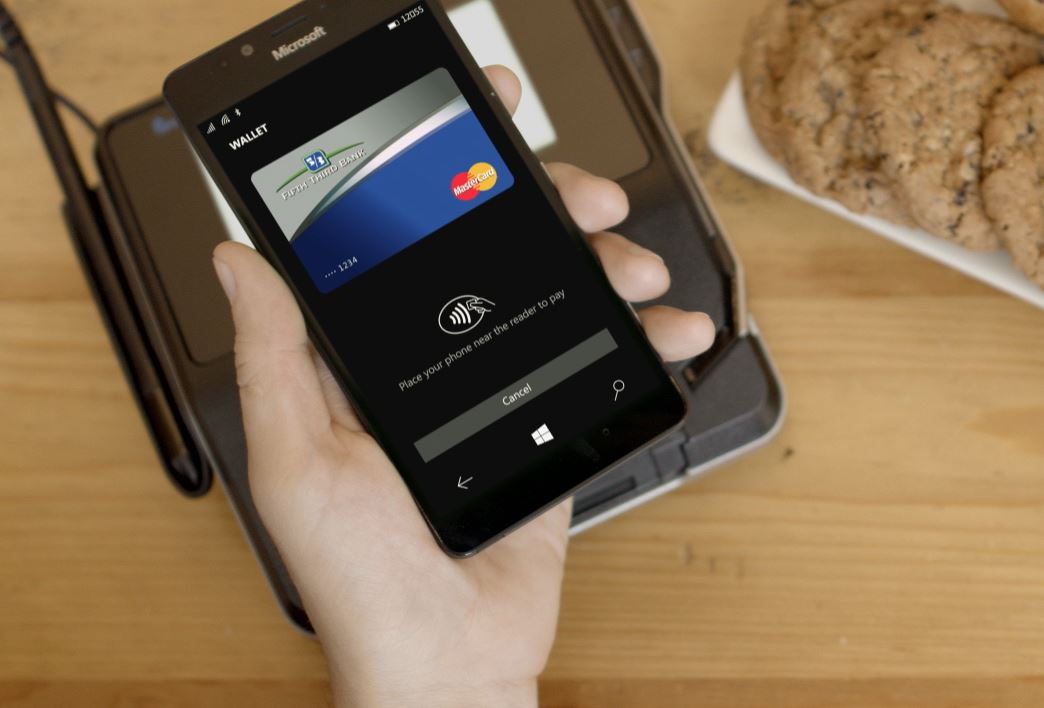Some points from recent history. Apple introduced a fingerprint sensor in the home button of the iPhone 5s in 2013, the initial use being unlocking the phone with a single press (Touch ID), but then also signing into applications that demanded some degree of security. The idea was developed in 2014 with the larger iPhone 6 and 6 Plus. Back in summer 2015, Apple launched Apple Pay, letting users with the iPhone 6 range, in multiple countries, pay for things with their phones with Touch ID, thanks also to use of NFC for proximity to sales terminals.
Note that neither technology was new - fingerprint sensors had existed in smartphones since the Motorola Atrix (running Android) in 2011, while NFC debuted with the Nokia C7 (running Symbian), I believe. However, the early fingerprint scanners were slow and clunky (you had to swipe your finger over a slot!) and the early NFC implementations played with easing device pairing and tapping on informational tags, two use cases which never really took off in the mainstream. As usual, Apple cherry picked from the ideas and implementations so far, focussed and polished things and the rest is history.
A year later, between summer 2016 and summer 2017, Microsoft experimented with Microsoft Wallet and Tap-to-Pay, albeit only in the USA. It did work, but there was also considerable work being done by Microsoft too, in forging liasons with the US banks and at some point it was decided that scalling all this up across the world to support a mobile OS market share of only about 4% at the time just wasn't worth it. In parallel, Microsoft was also making the decision to stop making Lumias and thus also sealing the fate of worldwide sales/share.

In short, a situation with diminishing returns. Could it have been different? Of course. A commitment to Lumia 950 production, continued price cuts, continued development of new models with metal and glass construction, all would have helped keep 'the third ecosystem' alive. Enough to make it worth making sure that an equivalent 'tap to pay' system worked in the Microsoft world as well.
The use of iris recognition as the authentication technology in the Lumia 950 range really didn't help, either. This did work after a fashion and was very secure, but it was much, much slower than simply tapping a finger on a fingerprint sensor and you have to wonder why Microsoft went with a more futuristic technology* when the older and simpler tech would have worked much better. The HP Elite x3 and Alcatel IDOL 4S/4 Pro rectified this with a proper back-mounted fingerprint sensor, but authentication was so tied with Windows Hello that a delay of over a second was common. And that's just not fast enough in today's mobile world (iPhones and most Android handsets identify a user in a fraction of a second).
*Notably, Samsung and others have all but abandoned their own attempts at iris recognition now, leaving just Apple's laser-scanning Face ID on its latest super-expensive iPhone X to carry the flag for authentication by looking at your phone.
So we have a dwindling market share and a stagnating installed base of devices, many of which couldn't authenticate for payment, or at least couldn't do this fast enough. You can excuse Microsoft, a couple of years behind the cutting edge, refusing to pour a billion or two into building up Microsoft Wallet/Pay.
It's not just tap-to-pay though - in Europe we're all so used to doing this with our debit cards that there's no really compelling use case for paying with the phone. But fingerprint authentication is useful for more than just paying for things. The biggest personal example is in Internet banking. It is just so convenient to log into my bank or building society accounts with a single tap on the fingerprint sensor on my Android smartphone, using the bank's own application. On Windows 10 Mobile, even if your bank has a UWP application, it almost certainly won't support biometric authentication too. So you have to resort to tapping in passwords or two factor identification manually and it just takes longer. Much longer. Assuming you can remember the appropriate login details.
Now, tying into Windows Hello within a UWP application is certainly possible, there are some excellent examples in our directory (e.g. Password Hello) - and, given a bigger ecosystem and more commitment from Microsoft, manufacturers and users, it would be entirely possible for a bank or building society to craft a sophisticated application that used a device's native biometrics for direct login.
Missed opportunities, poor engineering decisions, and bad timing all round then, perhaps.
Now, don't get me wrong, I still love using Windows 10 Mobile - the design, the Start screen, the way UWP applications adapt and work on multiple form factors, the Lumia audio and imaging wizardry. So much to like. Yet the lack of proper use of biometrics can make Windows phones poor relations to the competition in daily life.
Comments welcome - does lack of biometrics within applications (and payment in particular) matter to you? How do you get round bank logins? Maybe you have more patience than me!
